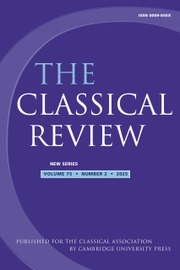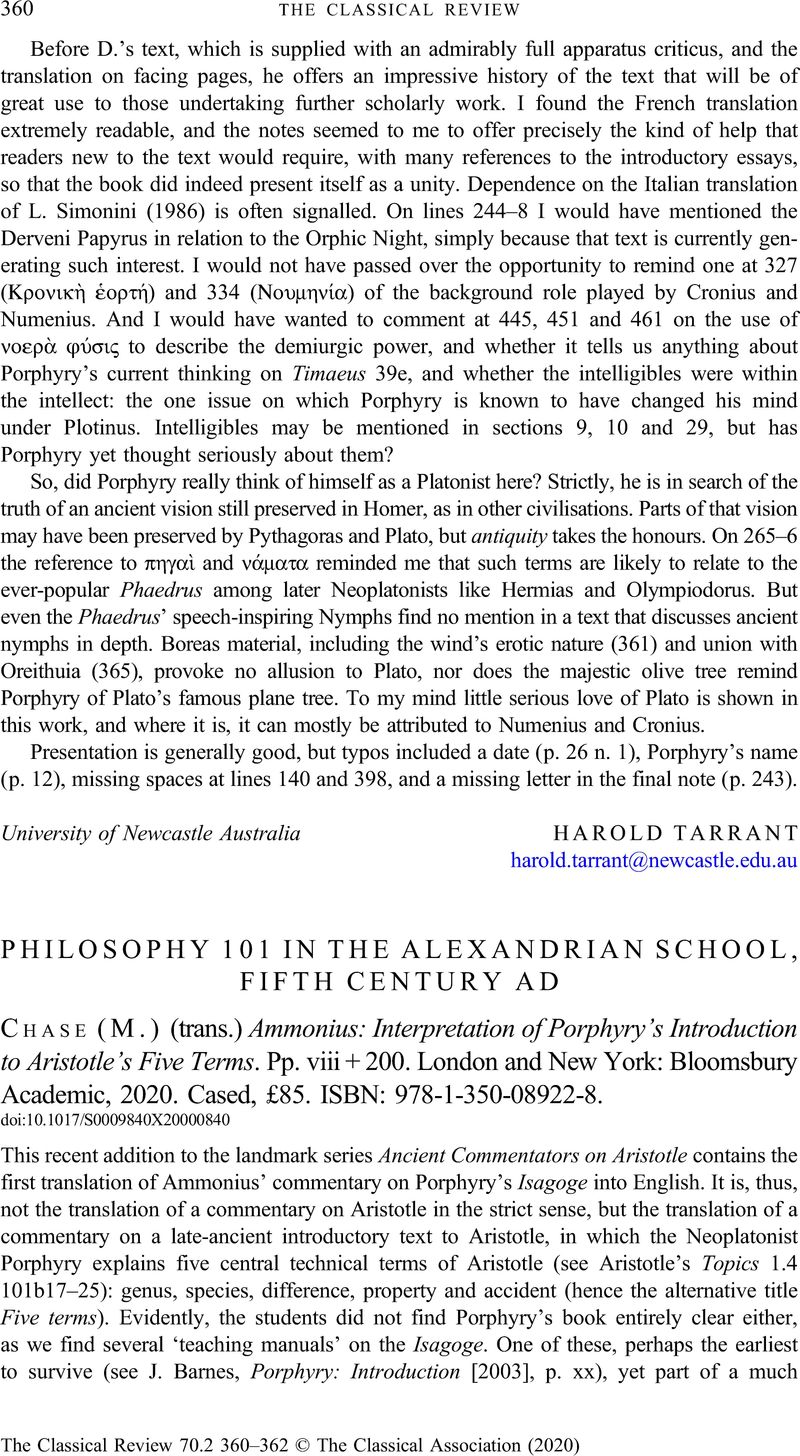This recent addition to the landmark series Ancient Commentators on Aristotle contains the first translation of Ammonius’ commentary on Porphyry's Isagoge into English. It is, thus, not the translation of a commentary on Aristotle in the strict sense, but the translation of a commentary on a late-ancient introductory text to Aristotle, in which the Neoplatonist Porphyry explains five central technical terms of Aristotle (see Aristotle's Topics 1.4 101b17–25): genus, species, difference, property and accident (hence the alternative title Five terms). Evidently, the students did not find Porphyry's book entirely clear either, as we find several ‘teaching manuals’ on the Isagoge. One of these, perhaps the earliest to survive (see J. Barnes, Porphyry: Introduction [2003], p. xx), yet part of a much older series of commentaries, is the now translated commentary ascribed to Ammonius (c. 445–517/526). Although this commentary refers only indirectly to Aristotle, it is well fitting that the translation was commissioned as a part of the Ancient Commentators series, as, like the Isagoge itself, much of the commentary aims at introducing students to Aristotle's terminology and ideas.
The translation is accompanied by a lucid introduction, a list of 44 textual emendations of A. Busse's 1891 edition (Commentaria in Aristotelem Graeca 4.3), a set of very short notes and an appendix of variant readings not included by Busse in the main text. Strangely, the appendix comes only after the notes to the text and contains its own little list of notes (p. 145); putting the textual variants closer to the translation and merging the notes would have been a more elegant solution. The book concludes with a concise bibliography, an English–Greek glossary, a Greek–English index and a subject index, all of which will be very useful to readers.
An important question that C. discusses in his short introduction is the authenticity of the commentary. In general C. subscribes to the standard account that most of Ammonius’ surviving work is based on students’ notes that were then collected for publication (p. 6). C. has no doubt that the present work is also based on lecture notes, but is uncertain whether the text is based on the lecture course of Ammonius. C. observes that, first, the work is far from polished; second, many passages from the Isagoge are repeated, which might indicate that the work builds on several sources; third, occasionally, alternative interpretations are given; fourth, there are some internal inconsistencies in the text. For these reasons C. decides to talk about ‘Ammonius(?)'s commentary’ (starting from p. 2), but of course these reasons are not at all conclusive. Although parts of the commentary are indeed mere paraphrases or ‘stupefyingly banal’ (C.'s words, p. 7), much of this could be explained as didactic tricks to convey the difficult material to its audience of novices.
The Ammonius commentary does not go straight to Porphyry's text, but first gives a lengthy introduction to philosophy, including what it is and what its parts are (pp. 17–30). Barnes contemptuously calls this ‘several pages of waffle’ (Barnes [2003], p. xv), but C. rightly notes that this part ‘provides precious insight into how philosophy was conceived in late antiquity’ (p. 6), and indeed it is as close to a life-recording of a late-ancient philosophy course as we can get. Ammonius then gives a presentation of some of Aristotle's Categories (the distinction between universal and particular, and the ten categories), before moving on to an introduction of the five terms and of Porphyry's Isagoge (pp. 30–6). Only after this does he move on to the line-by-line commentary on the Isagoge. Some of the material in the commentary is of genuine interest. For instance, to add to C.'s own list of his favourite passages (p. 6), there is a brief discussion of why the five terms are not five species under the common genus of ‘term’ (p. 65). Ammonius plausibly suggests that this applies to them qua words, whereas qua realities they do not share a common genus. Another interesting and detailed passage (pp. 101–3) compares the Aristotelian view that genera have contraries only potentially, with the Platonist view that genera have contraries actually. Since the genera, for the Platonists, are incorporeals, a genus is able for instance to be both a square and a sphere (i.e. there can be an incorporeal object which is a square circle!). Unfortunately, no explanatory note is given explaining exactly who these Platonists were. Ammonius argues that the Aristotelians and the Platonists are not in fact in disagreement, since they speak about different things, namely about universalia ante rem and universalia in re, respectively (p. 50).
As a translator, C. has done a marvellous job. He has produced a very readable and clear text. His translation is not only the first translation into English, but also the first published translation of the commentary into a modern language (there being, as C. notes on p. 8, one other translation into French hidden in the unpublished 2013 doctoral thesis of M.-J. Huh, Le premier commentaire de Boèce à l'Isagogè de Porphyre [Dissertation, Paris IV]). There are only a few things that might be improved upon. Especially, on p. 81, ὄν is in many cases translated as ‘being’, but in one case it is translated as ‘extant’, which the OED defines as ‘still in existence’. Yet the passage is not concerned with the question of persisting across time, and thus ‘extant’ seems the wrong translation. One wonders why C. did not use ‘(a) being’ here.
C. clearly strives to make the text available to readers with limited knowledge of Greek, as all Greek terms are transliterated, and the glossary and indexes help readers to cope with the Greek terminology. The ample notes are used to explain etymologies and homologies used by Ammonius, to give references to ancient texts and to provide clarifications of the translation. In addition, where Ammonius’ citations of Porphyry contain many extensive ellipses, C. provides the missing material from Porphyry in brackets; thus the volume contains a complete translation of the Isagoge (although having a copy of the Isagoge available is recommended). However, a few further resources should have been employed. First, C. does not add the headings found in Porphyry's text, but only adds the very few found in Ammonius’ text. Second, a more extensive division into headings could easily have been included in the list of contents, instead of only giving ‘Translation’ without any subdivisions. Lastly, the numbering in the margins of the text should have been explained: for instance, ‘1,5’ (in normal type) refers to p. 1, line 5 of Busse 1891; while ‘1,8’ (in bold) refers to p. 1, line 8 of Busse's 1887 edition of Porphyry's Isagoge (Commentaria in Aristotelem Graeca 4.1).
The appendix of variant readings highlights interesting material that is found in only some of the extant manuscripts or the editio princeps (printed in 1500 in Venice) of the text, which are buried in Busse's apparatus criticus (the last passage is, though, not from p. 127,5 of Busse's edition, but from p. 128,5). In addition, C. makes 44 textual emendations to Busse's edition and notes that ‘a new critical edition is a desideratum’ (p. 8). Given the poor state of the critical edition by Busse, it is difficult to judge the cogency of C.'s textual emendations. In any case, a stemma for the manuscripts, which neither Busse nor C. provides, would have been very useful for this purpose.
C.'s translation is a welcome addition to the Commentators series, and it makes available in translation a valuable source for the history of Aristotelianism and Neoplatonism in late antiquity.



